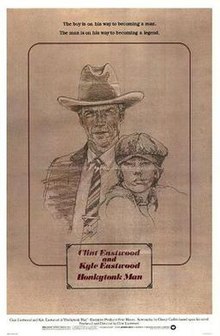Honkytonk Man
| Honkytonk Man | |
|---|---|
 Theatrical release poster | |
| Directed by | Clint Eastwood |
| Written by | Clancy Carlile |
| Produced by | Clint Eastwood |
| Starring |
|
| Cinematography | Bruce Surtees |
| Edited by |
|
| Music by | Steve Dorff |
Production company | |
| Distributed by | Warner Bros. |
Release date | December 15, 1982 |
Running time | 122 minutes |
| Country | United States |
| Language | English |
| Budget | $2 million[1] |
| Box office | $4,484,991[2] |
Honkytonk Man is a 1982 American musical drama film set in the Great Depression. Clint Eastwood, who produced and directed, stars with his son, Kyle Eastwood. Clancy Carlile's screenplay is based on his 1980 novel of the same name. This was Marty Robbins' last appearance before he died. The story of Clint's character, Red Stovall, is loosely based on the life of Jimmie Rodgers.
Plot
Itinerant western singer Red Stovall suffers from tuberculosis but has been given an opportunity to make it big at the Grand Ole Opry in Nashville, Tennessee. He is accompanied by his young nephew Whit. After a series of adventures which include the nephew's first sexual encounter in a brothel, they finally arrive.
While a fit of coughing in his audition ruins his chances, talent scouts for a record company are impressed enough to arrange a recording session, realizing that he has only days to live. The tuberculosis reaches a critical stage in the middle of this session, where Red's lines are filled in by Smokey, a side guitarist (country singer Marty Robbins in his last film role). Red eventually succumbs while Whit vows to tell his uncle's story. Red's vintage Lincoln Model K touring car, prevalent throughout the movie, finally 'dies' at the cemetery where Red is laid to rest.
Production
Filming took place over five weeks on location.[3] The first part of the movie was filmed in Bird's Landing, California.[3] However, the majority of this feature was filmed in and around Calaveras County, east of Stockton, California. Exterior scenes include Main Street, Mountain Ranch; Main Street, Sheepranch; and the Pioneer Hotel in Sheepranch. The famous jail break scene was filmed in Dayton, Nevada at the corner of Pike Street (the Lincoln Highway) and W Main Street. The vintage brick building the movie-built jail was attached to is the Odeon Hall, where Marilyn Monroe's paddle ball and bar interior scenes were shot in The Misfits (1961). Extras were locally hired and many of the towns residents are seen in the movie.
Cast
- Clint Eastwood as Red Stovall
- Kyle Eastwood as Whit Wagoneer
- John McIntire as Grandpa Wagoneer
- Alexa Kenin as Marlene Mooney aka Marlene Moonglow
- Verna Bloom as Emmy Wagoneer
- Matt Clark as Virgil Wagoneer
- Barry Corbin as Derwood Arnspriger
- Jerry Hardin as Snuffy
- Tim Thomerson as Highway Patrolman
- Macon McCalman as Dr. Hines
- Joe Regalbuto as Henry Axle
- Gary Grubbs as Jim Bob
- Marty Robbins as Smokey
- Tracey Walter as Pooch
Reception
Honkytonk Man received critical acclaim, and has a score of 93% on Rotten Tomatoes.[4] The New York Post wrote, "The pace is slow, very country, but it rises to touching moments...not all perfect by any means, but ultimately a story of occasional awkward truths."[5]
The film opened Wednesday, December 15, 1982 in Los Angeles before expanding to 677 screens for the weekend, but only grossed $667,727, the worst opening for an Eastwood film.[6][7] The film went on to gross $4.5 million at the United States and Canada box office,[8] Eastwood's lowest grosser for more than a decade.[9] The film was nominated for a Razzie Award for Worst Original Song for No Sweeter Cheater than You.[10]
References
- ^ Thompson, p.82
- ^ "Honky Tonk Man (1982) - Box Office Mojo". www.boxofficemojo.com. Retrieved 7 July 2017.
- ^ a b Hughes, p.136
- ^ "Honkytonk Man". Rotten Tomatoes. Retrieved 6 December 2013.
- ^ Hughes, p.138
- ^ Ginsberg, Steven (December 21, 1982). "'Tootsie,' 'Toy' And 'Dark Crystal' Win Big At National Box-Office". Daily Variety. p. 1.
- ^ Honkytonk Man at the AFI Catalog of Feature Films
- ^ Hughes, p.137
- ^ "Clint Eastwood". Box Office Mojo. Archived from the original on July 15, 2018. Retrieved May 16, 2020.
- ^ Wilson, John (2005). The Official Razzie Movie Guide: Enjoying the Best of Hollywood's Worst. Grand Central Publishing. ISBN 0-446-69334-0.
Bibliography
- Hughes, Howard (2009). Aim for the Heart. London: I.B. Tauris. ISBN 978-1-84511-902-7.
- Thompson, David (1999). "Cop on a Hot Tightrope". In Robert E., Kapsis; Coblentz, Kathie (ed.). Clint Eastwood: Interviews. University Press of Mississippi. pp. 81–95. ISBN 1-57806-070-2.
{{cite book}}: CS1 maint: multiple names: editors list (link)

